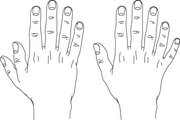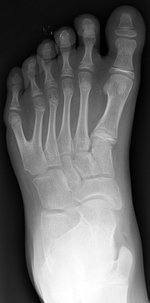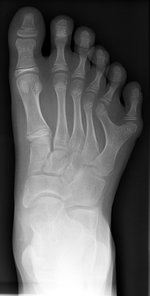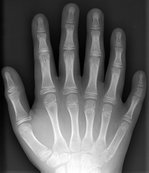We were surprised to count six toes on the left leg of St Joseph in Raphael's famous painting of "The Marriage of the Virgin" (Milan, Pinacoteca di Brera), painted in 1504. This is probably not due to the carelessness of this painter, well known for his attention to detail; moreover, St Joseph is the only barefooted figure in the painting. One can easily detect a well formed extra digit (detail of fig 1) articulating with the fifth toe, corresponding to a postaxial polydactyly of type A. This is a relatively rare anomaly in white people, occurring in 1 in 630 to 1 in 3300 live births.[1]
[Figure ILLUSTRATION OMITTED]
Puzzled by this finding, we searched for and found another example in Raphael's work--in the infant John the Baptist gazing at the Christ child in "La belle Jardiniere" (Paris, Musee National du Louvre). Since postaxial polydactyly is an autosomal dominant trait, we may hypothesize that the two people who had served as models for Raphael were relatives, probably father ("St Joseph") and son ("the infant").
BMJ 2000;321;1622
We are deeply indebted to Mr Jean-Pierre Cuzin, Louvre museum, Paris, for his artistic advice.
[1] Temtamy SA. Polydactyly. In: Bergsma D, ed. Birth defect compendium. 2nd ed. New York: Alan R Liss, 1979:873.
Daniel Mimouni, Rabin Medical Center, Petah Tiqva, Israel; Francis B Mimouni, Lis maternity hospital, Tel Aviv Sourasky Medical Center, Tel Aviv, Israel; Marc Mimouni, Schneider Children's Medical Center of Israel, Tel Aviv.
COPYRIGHT 2000 British Medical Association
COPYRIGHT 2001 Gale Group






